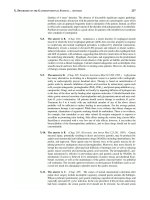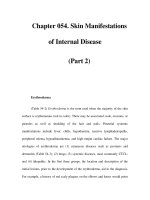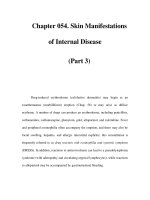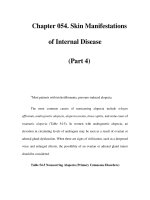Chapter 054. Skin Manifestations of Internal Disease (Part 7) ppsx
Bạn đang xem bản rút gọn của tài liệu. Xem và tải ngay bản đầy đủ của tài liệu tại đây (12.95 KB, 5 trang )
Chapter 054. Skin Manifestations
of Internal Disease
(Part 7)
Telangiectasias
(Table 54-8) In order to distinguish the various types of telangiectasias, it is
important to examine the shape and configuration of the dilated blood vessels.
Linear telangiectasias are seen on the face of patients with actinically damaged
skin and acne rosacea, and they are found on the legs of patients with venous
hypertension and essential telangiectasia. Patients with an unusual form of
mastocytosis (telangiectasia macularis eruptiva perstans) and the carcinoid
syndrome (see "Acne," above) also have linear telangiectasias. Lastly, linear
telangiectasias are found in areas of cutaneous inflammation. For example, lesions
of discoid lupus frequently have telangiectasias within them.
Table 54-8 Causes of Telangiectasias
I. Primary cutaneous disorders
A. Linear
1. Acne rosacea
2. Actinically damaged skin
3. Venous hypertension
4. Essential telangiectasia
5. Within basal cell carcinomas
B. Poikiloderma
1. Ionizing radiation
a
2. Poikiloderma vasculare atrophicans
C. Spider angioma
1. Idiopathic
2. Pregnancy
II. Systemic diseases
A. Linear
1. Carcinoid
2. Ataxia-telangiectasia
3. Mastocytosis
B. Poikiloderma
1. Dermatomyositis
2. Cutaneous T cell lymphoma
3. Xeroderma pigmentosum
C. Mat
1. Scleroderma
D. Periungual
1. Lupus erythematosus
2. Scleroderma
3. Dermatomyositis
4. Hereditary hemorrhagic telangiectasia
E. Papular
1. Hereditary hemorrhagic telangiectasia
F. Spider angioma
1. Cirrhosis









